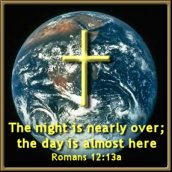
|
The Four Beasts of Daniel (Dan. 7:1-8)According to the Traditional or Amillennial approach, the prophecies of Daniel chapter seven began in 606 BC and will end with the first coming of the Lord Jesus Christ. I object to this view because I believe that the prophecies end with the smiting stone (Dan. 2:35, 45) striking the feet of the image or at the Second Coming rather than the first coming of our Lord Jesus Christ. Therefore I reject the Amillennial view in favor of the Premillennial approach to the prophecies of Daniel chapters two and seven.
The Semi-historical view of Daniel chapter seven begins with the Media-Persian empire symbolized by the lion (Dan. 7:4) and ends with the New World Order represented by the fourth beast (Dan. 7:7-8). This view seems to be based on the phrase "shall arise" (Dan. 7:17) indicating the four kingdoms would arise after the Babylonian empire which was passing off the scene at the time of Daniel"s vision in the "first year of Belshazzar king of Babylon" (Dan. 7:1). I would have to object to this view based on several considerations: first, concerning the phrase "shall arise" (Dan. 7:17) which could possibly be translated without jeopardizing the symbol of the lion (Dan. 7:4) representing the Babylonian empire. Lehman Strauss notes:
Secondly, I believe the four beasts represent four succeeding kingdoms or empires, which parallel the four kingdoms of Nebuchadnezzar"s metal image in Daniel chapter two. W.C. Stevens in his commentary, The Book of Daniel, states:
Why then was Daniel given another vision of the four kingdoms represented by the four beasts in chapter seven? Daniel chapter two gives us the "Times of the Gentiles" from man"s point of view, whereas, chapter seven gives us God"s perspective. Man sees history as an upward evolution depicting his power and majesty, whereas, God sees man"s history as a collection of wild beasts devouring one another. Also, according to Clarence Larkin, "this Vision of the "Wild Beasts" was given to Daniel that he might have additional light on the "Times of the Gentiles"" (120). This is especially true concerning the "little horn" and his rise to power in the first half of Daniel"s seventieth week.
Concerning the Church Age View, I do not have any problems with this approach other than I find it unnecessary, as it really doesn"t provide anything that substantial to the already listed four empires that would exist up until the time of the Second Coming. One must also take into consideration that America and Russia have never really been world empires in the sense that Babylon, Medo-Persia, Greece, and Rome were. There is also some disagreement concerning the symbol of the leopard (some see it as Nazi Germany and there are some other variations as well). W.A. Criswell covers this in his Expository Sermons on the Book of Daniel as follows:
The Double Reference View states that the Second Coming could have followed the first coming almost immediately. I have no objections to this view whatsoever; in fact, this is the view that most pre-trib scholars espouse and is called the Postponement View and is the reasoning behind the fact that if the Jews had accepted Christ at His first coming John the Baptist would have been the prophet Elijah spoken of in the Book of Malachi (See also Matt. 17:9-11). Yet the view that Daniel seven could have been Medo-Persia, Greece, and Rome, but they instead came to represent Britain, Russia, and the United States I would have to object to on the grounds stated in the arguments concerning the other approaches stated earlier (See previous arguments concerning the Semi-historical and Church Age views).
Therefore, I believe that the four beasts of Daniel seven are representative of the kingdoms of Babylon, Medo-Persia, Greece, and Rome (which would be revived in the form of a ten-toed federation ruled over by the "little horn" or antichrist). This last days counterfeit kingdom will be destroyed by the Lord Jesus Christ at his Second Coming depicted by the "stone" of Daniel 2:45. The millennial or "stone" kingdom spoken of by the Old Testament prophets will follow the antichrist"s kingdom, which John also describes in the twentieth chapter of The Book of Revelation.
Criswell, W.A. Expository Sermons on the Book of Daniel. Grand Rapids: Zondervan Publishing House, 1976.
Larkin, Clarence. The Book of Daniel. Glenside, PA: Rev. Clarence Larkin Estate, 1929.
Stevens, W.C. The Book of Daniel. Los Angeles: Bible House of Los Angeles, 1918.
Strauss, Lehman. The Prophecies of Daniel. Neptune, NJ: Loizeaux Brothers, 1969.
| |
| Copyright © 2001 - 2023, Prophecy Forum, All Rights Reserved. | ||